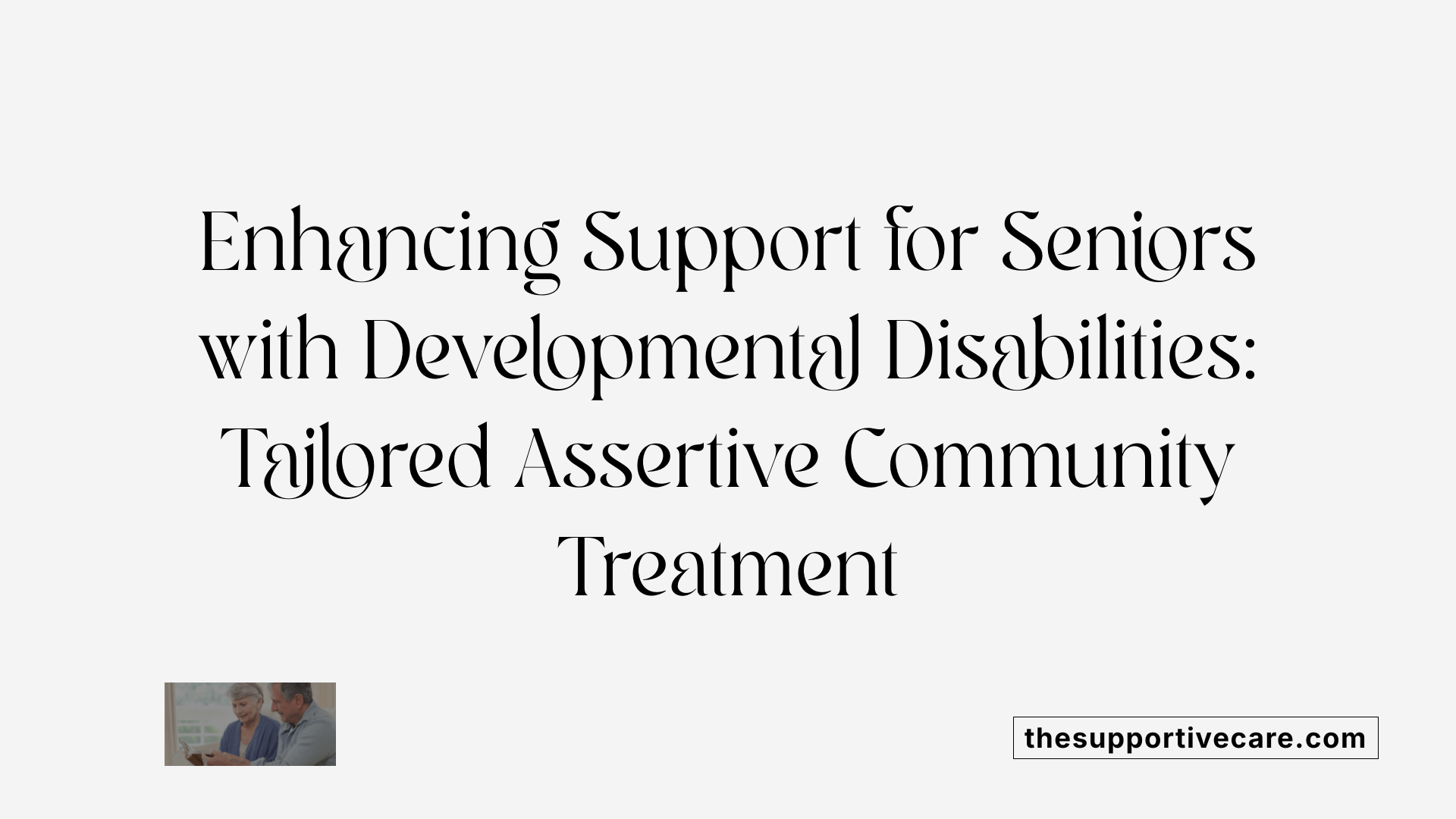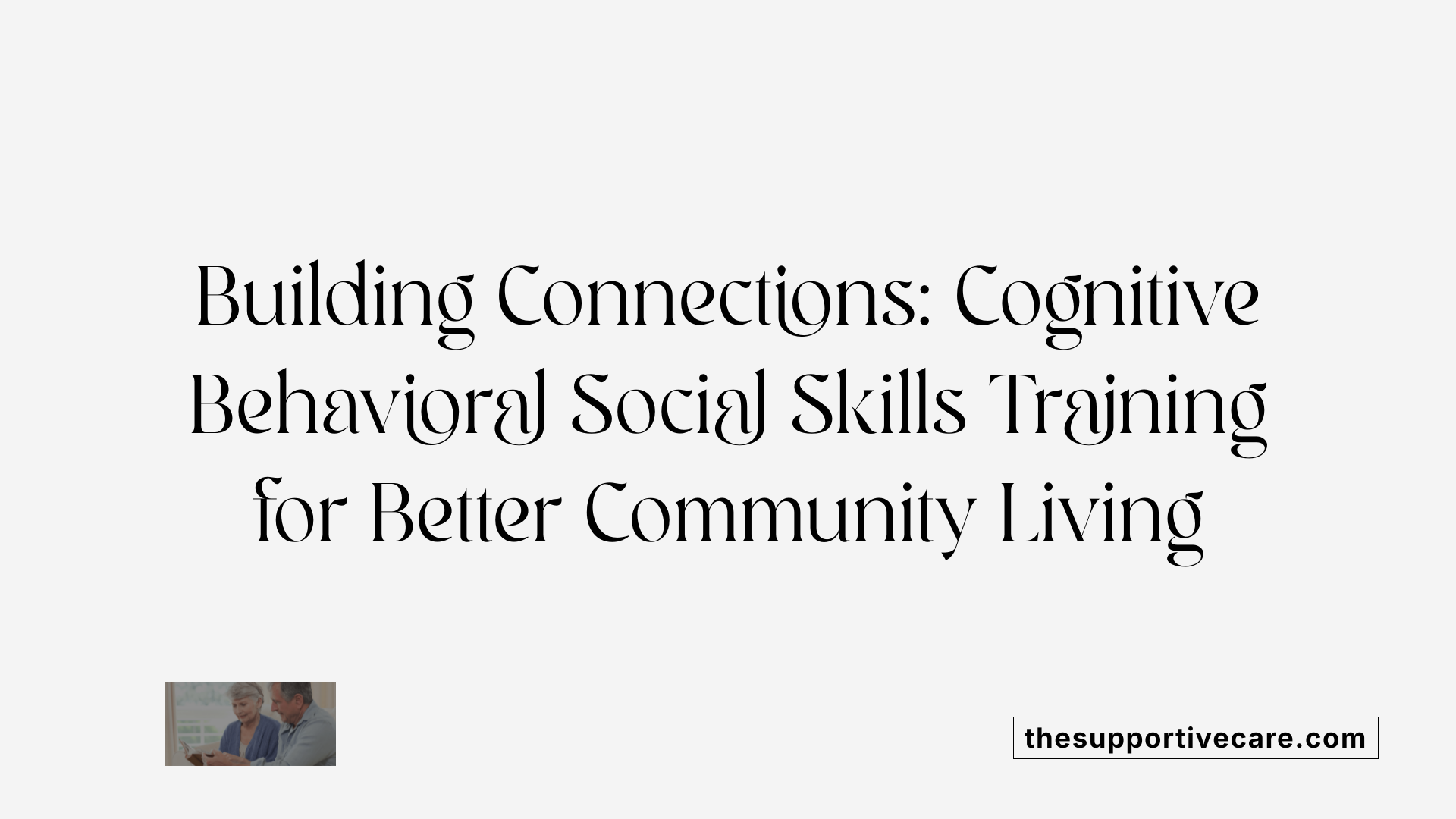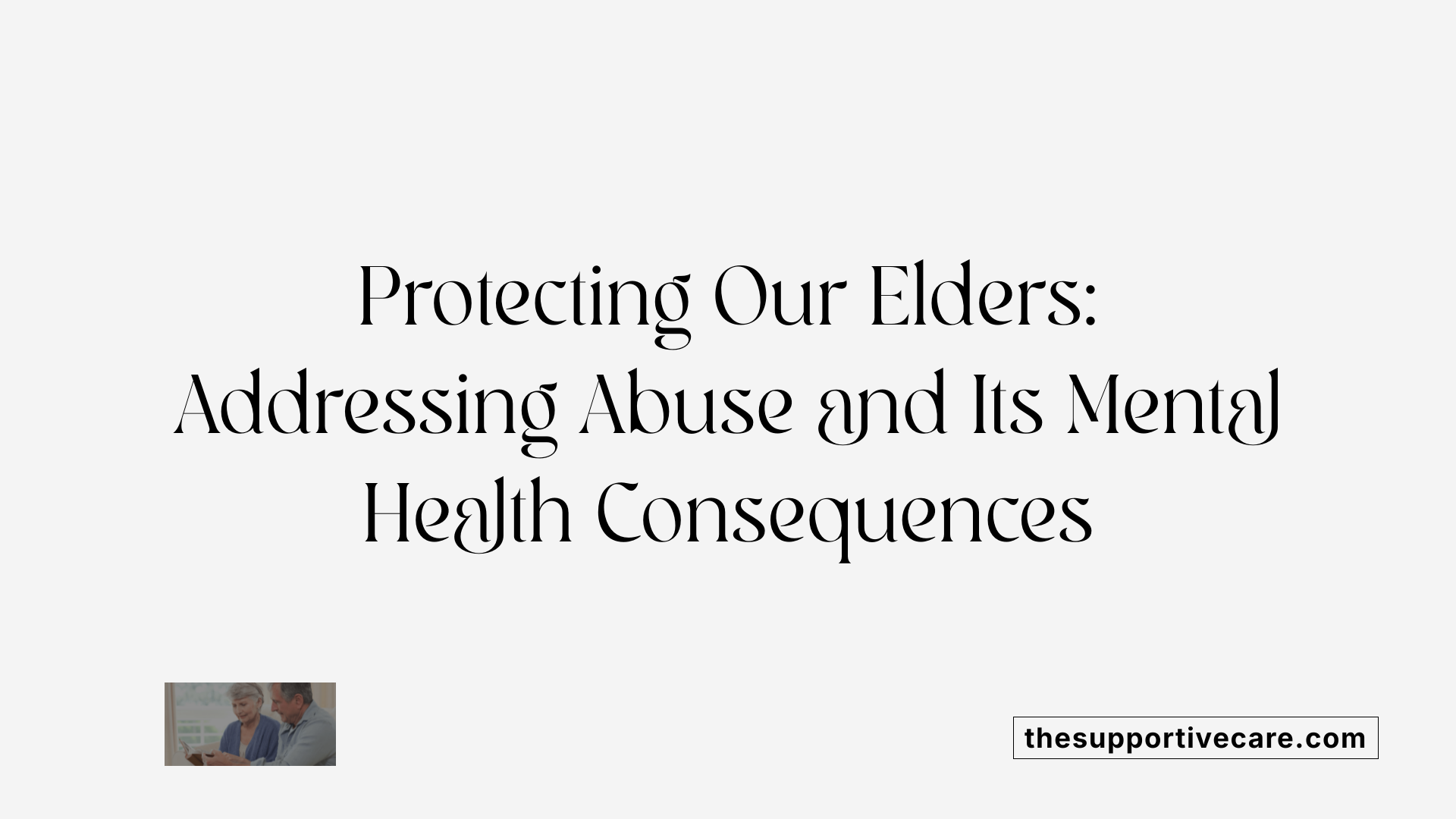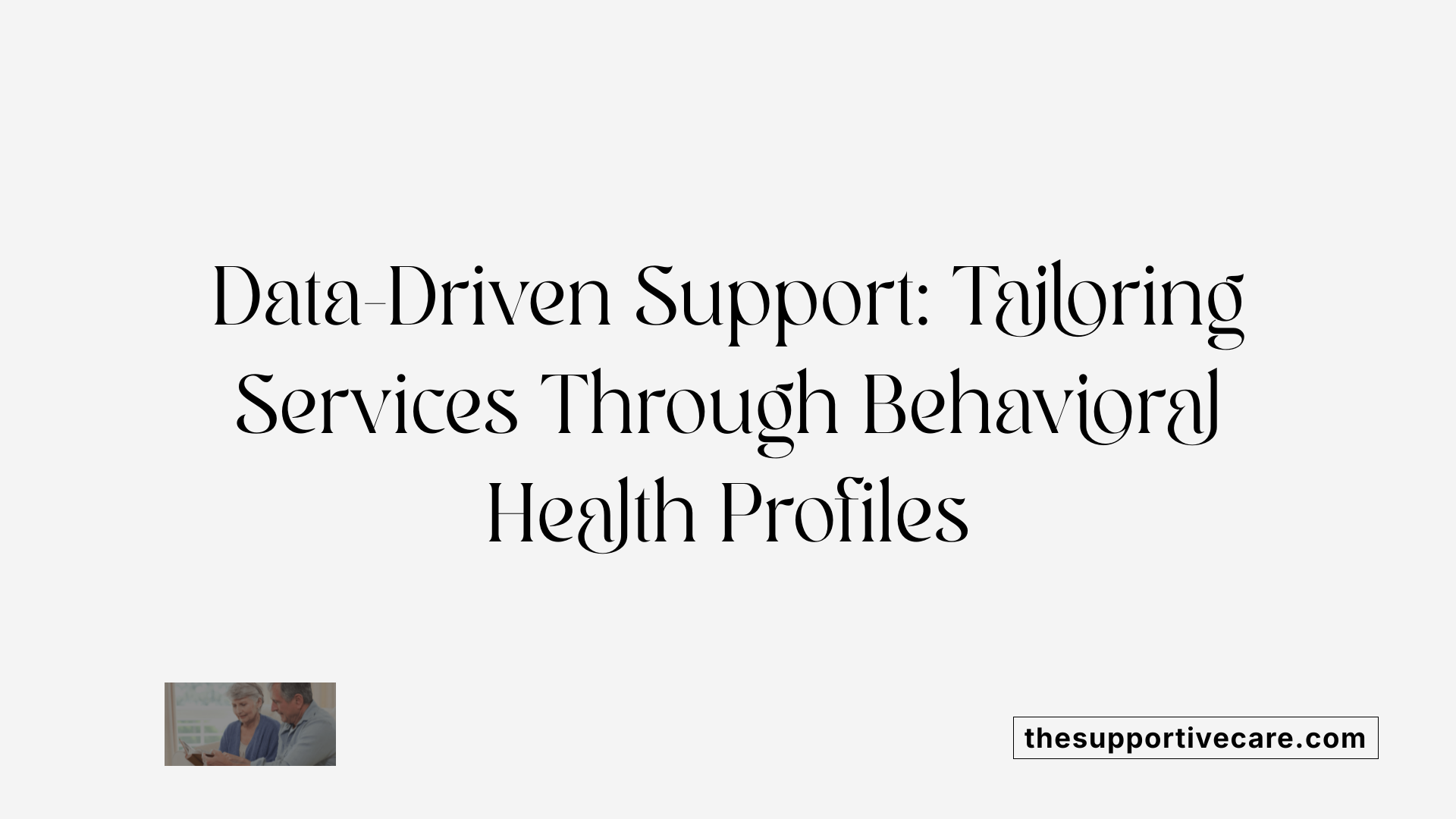Addressing the Mental Health Needs of Aging Adults with Developmental Disabilities
As the global population ages, an increasing number of seniors live with developmental disabilities (IDD) facing complex mental health challenges. Behavioral therapy tailored to this population is critical for enhancing quality of life, promoting independence, and addressing co-occurring mental and substance use disorders. This article explores the latest advances in comprehensive treatment approaches, the integration of mental health and addiction services, and specialized interventions designed to meet the unique needs of seniors with developmental disabilities.
Understanding the Growing Need for Specialized Behavioral Therapy in Seniors with Developmental Disabilities
Aging Population Trends
The global population of older adults is rapidly increasing, with a significant portion living beyond 70 years old. This demographic shift highlights an urgent need to address complex health issues, including mental health challenges, particularly in seniors with developmental disabilities (IDD). These individuals often face unique vulnerabilities due to their cognitive and social impairments.
Mental Health Challenges in Seniors with IDD
Older adults with intellectual and developmental disabilities experience higher rates of mental health issues such as anxiety, depression, and suicidal thoughts. Despite this, they are frequently underserved because of limited specialized mental health services, insufficient clinical training, and discomfort among providers treating this population. Challenges include diagnostic overshadowing, where symptoms are mistaken for aspects of their developmental conditions, leading to underdiagnosis and inadequate treatment.
Prevalence of Psychiatric Symptoms and Substance Use Disorders
Psychiatric symptoms like irritability or agitation are common in seniors with IDD and may manifest differently compared to the general older adult population. Substance use disorders, especially involving alcohol and prescription medications, are also important concerns but often go unrecognized among older adults, including those with developmental disabilities. Tailored screening and interventions are essential for effective management.
Addressing the Need for Specialized Behavioral Therapy
Standard treatments such as cognitive behavioral therapy (CBT) are adapted to the cognitive levels and communication styles of adults with IDD, often incorporating visual aids and multisensory strategies. Emphasis on person-centered planning and self-determination helps engage these seniors directly in their care decisions. Advancing clinician training through specialized resources and collaborative care models can markedly improve service access and outcomes for this growing population.
Common Mental Health Disorders Among Seniors with Developmental Disabilities
What are the common mental health disorders among seniors with developmental disabilities?
Older adults with intellectual and developmental disabilities (IDD) frequently experience mental health challenges, including depression, anxiety, and neurocognitive disorders such as dementia. These conditions occur alongside higher rates of co-occurring mental illnesses like schizophrenia and substance use disorders, compounding the complexity of care needs.
How do these disorders manifest differently in IDD populations?
Mental health issues in seniors with IDD often present uniquely. For example, adults with Down syndrome may exhibit irritability or behavioral changes instead of traditional verbal expressions of depression. Diagnostic overshadowing can occur when symptoms are misattributed to developmental conditions rather than underlying psychiatric disorders. This necessitates careful screening using specialized tools such as the Reiss Screen for Maladaptive Behavior and PAS-ADD Checklist to accurately identify mental health issues.
What is the impact of co-occurring conditions such as schizophrenia and substance use disorders?
Co-occurring conditions like schizophrenia and substance use disorders significantly increase the risk of disability and poor health outcomes in older adults with IDD. Schizophrenia affects community functioning and social interaction, while substance misuse, including alcohol and prescription medications, is often underrecognized but poses serious health risks. Tailored interventions, including behavioral health integration and harm reduction strategies, aim to improve symptom management and enhance quality of life for this vulnerable population.
The Challenge of Diagnostic Overshadowing and Atypical Symptom Presentation in Seniors with IDD
What is Diagnostic Overshadowing and Why Does it Matter?
Diagnostic overshadowing occurs when symptoms of mental health disorders in adults with intellectual and developmental disabilities (IDD) are mistakenly attributed solely to their developmental conditions rather than being recognized as separate, treatable issues. This misattribution often leads to underdiagnosis and undertreatment of mental disorders in this vulnerable population, delaying effective interventions and impacting overall wellbeing.
How Do Symptoms Differ in Older Adults with IDD?
Adults with IDD may express mental health issues differently from the general population. For example, rather than verbalizing feelings of depression, individuals with Down syndrome might exhibit irritability or behavioral changes. Such atypical symptom presentation complicates diagnosis and requires sensitivity to nonverbal and behavioral cues.
Strategies for Accurate Assessment and Differential Diagnosis
To overcome diagnostic overshadowing, assessment tools tailored for adults with IDD—such as the Reiss Screen for Maladaptive Behavior and the PAS-ADD Checklist—are critical. Clinicians should conduct thorough evaluations that discern mental health symptoms from baseline developmental traits. Moreover, involving specialized interdisciplinary teams and using person-centered communication techniques enhance diagnostic accuracy. Recognizing these nuances ensures that mental health conditions are appropriately identified and treated, promoting better health outcomes for seniors with IDD.
Screening Tools and Techniques Tailored for Seniors with Developmental Disabilities
Which Screening Tools Are Recommended for Seniors with Developmental Disabilities?
For older adults with developmental disabilities (IDD), specialized tools help accurately identify mental health concerns. The Reiss Screen for Maladaptive Behavior, PAS-ADD Checklist, and ASEBA are commonly used. These tools are designed to capture behavioral and emotional problems that may present differently in this population compared to neurotypical seniors.
How Are Screenings Adapted for Cognitive and Communication Challenges?
Screening in this group requires thoughtful adaptations due to varied cognitive levels and communication styles. Simplified language, visual aids, and multisensory techniques enhance comprehension. Clinicians often engage directly with individuals, respecting preferences for identity-first or person-first language, and adapt communication to empower seniors with IDD.
Why Is Routine Assessment Important for Mental Health and Daily Functioning?
Regular evaluation of mental health symptoms alongside daily living activities is crucial. Many adults with IDD exhibit mental health symptoms that might be atypical or masked by their developmental conditions, a phenomenon known as diagnostic overshadowing. Routine assessments ensure early detection and appropriate intervention, promoting psychological well-being and functional independence.
This approach, combined with personalized therapy and social support, helps mitigate mental health challenges in seniors with developmental disabilities and supports successful aging.
Comprehensive Treatment Services for Substance Abuse and Mental Health Issues Among Seniors with Developmental Disabilities

What comprehensive treatment services are available for substance abuse and mental health issues?
Comprehensive treatment services for older adults, including those with developmental disabilities, combine integrated and tailored approaches to effectively address substance abuse and mental health conditions. These services begin with medical detoxification, which safely manages withdrawal symptoms, considering the unique needs and vulnerabilities of seniors with developmental disabilities.
Following detox, adapted rehabilitation programs—both inpatient and outpatient—offer structured support focusing on the older adult’s cognitive and physical abilities. These programs emphasize multidisciplinary care that includes physical, mental, and social health coordination.
Counseling and therapeutic modalities are core components, with adaptations such as simplified language, visual aids, and multisensory techniques to suit cognitive levels of adults with developmental disabilities. Cognitive Behavioral Therapy (CBT), tailored to individual thinking styles, is widely used to manage co-occurring mental health issues and substance misuse. Trauma-informed care further enhances therapy by acknowledging past experiences and promoting resilience.
Medication-assisted treatment (MAT) plays a crucial role in managing dependencies, particularly for opioids and alcohol. Seniors are closely monitored to prevent adverse effects and interactions with existing medications, adapting dosing and treatment plans accordingly.
Sustained recovery support incorporates ongoing case management, relapse prevention, and involvement in peer support groups. These services maintain engagement in treatment, social connection, and community integration. The multidisciplinary teams collaborate continuously to address developmental, behavioral, and mental health needs—ensuring a holistic framework that supports well-being and quality of life for seniors with developmental disabilities facing substance use and mental health challenges.
Importance of Integrating Mental Health and Substance Abuse Treatment for Seniors with Developmental Disabilities
Why is it important to integrate mental health services with substance abuse treatment?
Mental health disorders frequently co-occur with substance use disorders, especially among seniors with developmental disabilities. Treating these conditions separately often results in less effective care. Integration ensures that both mental health and substance abuse issues are addressed simultaneously, fostering a comprehensive treatment plan tailored to the individual's complex needs.
Integrated treatment reduces stigma by normalizing care for both disorders together. This helps seniors and their caregivers feel less isolated and more willing to pursue and stay engaged with treatment services. Additionally, this model lowers barriers to accessing care, which is particularly crucial for older adults with developmental disabilities who often face challenges in navigating health systems.
By addressing underlying mental health problems, integrated care can reduce triggers that lead to substance use relapse. This approach improves the likelihood of long-term recovery and supports better overall health outcomes. It also encourages collaboration between behavioral health specialists and medical providers, enhancing coordination that benefits patient safety and continuity of care.
Benefits of integrated treatment models
- Comprehensive care: Simultaneous treatment of mental health and substance use disorders.
- Improved patient engagement: Reduces stigma and helps maintain treatment adherence.
- Enhanced collaboration: Multidisciplinary teams tailor care plans.
- Relapse prevention: Early detection and management of co-occurring symptoms.
Implementing such integrated programs for seniors with developmental disabilities requires adaptations to communication styles, careful screening, and specialized training for clinicians. This ensures therapies like cognitive behavioral approaches are accessible and effective for this population.
Impact on relapse prevention and long-term outcomes
Integrated care leads to reduced hospitalizations, improved psychosocial functioning, and better quality of life. It can mitigate diagnostic overshadowing where substance use problems are overlooked due to developmental disabilities. Seniors receiving integrated services experience fewer relapses and enhanced social and community involvement.
In sum, integrating mental health and substance abuse treatment for seniors with developmental disabilities fosters holistic recovery, addresses complex clinical needs, and promotes sustained well-being over time.
Addressing Behavioral Addictions Beyond Substance Abuse for Seniors with Developmental Disabilities
How do treatment programs address various forms of addiction beyond substance abuse?
Treatment approaches targeting behavioral addictions in seniors with developmental disabilities adopt a comprehensive, biopsychosocial framework. These programs recognize addictions such as gambling, problematic internet use, compulsive shopping, sex, and exercise as distinct from substance misuse but equally impactful on mental health.
Evidence-based therapies form the cornerstone of intervention. Cognitive-behavioral therapy (CBT) helps patients identify and modify compulsive thoughts and behaviors driving the addiction. Motivational interviewing supports readiness for change by strengthening intrinsic motivation, while mindfulness techniques increase awareness of triggers and reduce impulsivity.
Peer support plays a pivotal role in recovery. Self-help groups like Gamblers Anonymous or Sex Addicts Anonymous provide social connection and accountability, which are vital for sustained remission. In addition, family therapy fosters healing by improving communication and addressing relational dynamics that might contribute to or result from addictive behaviors.
Personalized assessment is essential for effective treatment planning. Clinicians use tailored screening tools to evaluate the type and severity of behavioral addictions and any co-occurring mental health conditions. These assessments guide development of individualized treatment plans that are sensitive to cognitive capacities and communication preferences of seniors with developmental disabilities.
Integrating these components within multidisciplinary care enables holistic support, acknowledging that recovery involves more than symptom reduction—it includes the promotion of resilience, social engagement, and general well-being among this vulnerable population.
Psychosocial Interventions and Therapeutic Models for Older Adults with Serious Mental Illness and Developmental Disabilities
What are the main psychosocial interventions for older adults with serious mental illness (SMI)?
Several evidence-based psychosocial interventions cater specifically to older adults living with SMI. These include:
Assertive Community Treatment (ACT): A multidisciplinary, intensive community-based model targeting adults aged 50 and older. ACT improves treatment initiation, retention, and adherence through tailored support.
Cognitive Behavioral Social Skills Training (CBSST): Combines cognitive-behavioral therapy with social skills development. This approach has demonstrated improvements in independent functioning and social interaction, especially beneficial for older adults with schizophrenia.
Functional Adaptation Skills Training (FAST): Focuses on practical daily living skills such as medication management, communication, transportation, and financial handling. FAST enhances community functioning and reduces psychiatric symptoms.
Integrated Illness Management and Recovery (I-IMR): Designed for those with co-occurring chronic medical conditions, it promotes self-management of both mental and physical health, reducing hospitalizations and improving overall functioning.
Helping Older People Experience Success (HOPES): Provides wide-ranging skills training in social, community, and health domains, leading to sustained improvements in quality of life and independent living skills.
How do these interventions assist adults with developmental disabilities?
Adults with intellectual and developmental disabilities (IDD) face unique mental health challenges and often require adaptations in psychosocial interventions. Modifications include simplifying language, using visual aids, and applying multisensory approaches to accommodate cognitive levels and thinking styles.
Therapeutic engagement emphasizes empowering adults with IDD through direct communication and respecting language preferences (identity-first or person-first). Screening tools tailored for this population, such as the PAS-ADD Checklist, support accurate diagnosis and help avoid misattribution of symptoms.
What is critical for effective implementation?
Successful deployment of these psychosocial models involves:
- Needs assessment to customize approaches
- Staff training and fidelity monitoring
- Outcome measurement
- Cultural relevance adaptation
- Organizational support and sustainable funding
This comprehensive framework ensures that therapeutic approaches meet the diverse and complex needs of older adults with SMI and developmental disabilities, enhancing their community living skills and overall quality of life.
Assertive Community Treatment (ACT) Tailored for Seniors with Developmental Disabilities

What is Assertive Community Treatment (ACT)?
Assertive Community Treatment (ACT) is a multidisciplinary approach delivering intensive, community-based support tailored to adults, particularly those aged 50 and older, with serious mental illness (SMI). This model is designed to provide individualized care plans addressing medical, psychological, and social needs.
How does ACT support seniors with developmental disabilities?
For seniors living with developmental disabilities and co-occurring mental health issues, ACT offers comprehensive support that helps manage complex care requirements. Its multidisciplinary teams typically include psychiatrists, social workers, nurses, and occupational therapists working collaboratively to ensure holistic treatment.
What are the key components of ACT in this population?
- Individualized Care Planning: ACT teams customize treatment strategies to reflect the unique needs, preferences, and goals of each senior, focusing on maintaining independence and improving quality of life.
- Intensive Community-Based Support: Regular outreach and coordination with mental health clinics, primary care providers, and social services enable continuous monitoring and timely intervention.
- Increased Treatment Adherence: ACT has demonstrated success in improving medication compliance and treatment engagement by providing consistent support and building trusting relationships.
What benefits does ACT provide to adults aged 50+ with SMI and developmental disabilities?
ACT reduces hospitalizations and improves treatment retention, leading to better mental health outcomes. Seniors experience enhanced functioning, greater stability, and improved capacity to live successfully within the community. The approach also helps reduce caregiver burden by offering supportive resources.
By integrating medical, behavioral, and social care, ACT exemplifies a tailored, age-friendly model that addresses the unique challenges faced by older adults with developmental disabilities.
Cognitive Behavioral Social Skills Training (CBSST) to Enhance Community Functioning

What is CBSST?
Cognitive Behavioral Social Skills Training (CBSST) combines principles of cognitive behavioral therapy with targeted social skills training. This integrated approach helps individuals improve how they think and behave in social situations, boosting their ability to function independently within their communities.
How does CBSST improve social interactions and independent living?
CBSST focuses on enhancing communication, problem-solving, and other social skills that older adults need to live more independently. By addressing negative thinking patterns and promoting practical social techniques, CBSST supports participants in forming better interpersonal relationships and managing daily activities effectively.
Is CBSST effective for older adults with schizophrenia and developmental disabilities?
Research shows CBSST is particularly effective for older adults living with schizophrenia, significantly improving their social functioning and ability to live independently. The training has also been adapted to meet the needs of adults with developmental disabilities. When tailored properly, CBSST can enhance social skills and quality of life in these populations, fostering greater community engagement and psychosocial success.
Functional Adaptation Skills Training (FAST) and PEDAL Programs for Improved Daily Living
What Skills Do FAST and PEDAL Teach in Older Adults?
Functional Adaptation Skills Training (FAST) and the PEDAL program focus on enhancing essential daily living skills among older adults, especially those with serious mental illness (SMI) or developmental disabilities. They teach practical abilities including medication management, social interactions, communication skills, transportation use, organization, and financial management. These competencies empower individuals to navigate everyday challenges effectively and promote autonomy.
How Do These Programs Impact Psychiatric Symptoms?
Evidence shows that FAST and PEDAL lead to significant improvements in psychiatric symptoms. Participants demonstrate better symptom management, reduced functional impairments, and enhanced coping strategies. By addressing both practical life skills and psychiatric needs, these programs provide holistic support that goes beyond symptom relief to encourage sustained recovery.
How Do FAST and PEDAL Promote Independence and Quality of Life?
Increasing independence is a central goal of the FAST and PEDAL interventions. By equipping older adults with vital skills, these programs foster greater self-sufficiency in managing medication, finances, and communication. This, in turn, enhances their quality of life by enabling fuller community participation, reducing reliance on caregivers, and supporting mental wellness. Participants often report feeling more confident and engaged in their daily environments after completing these programs.
Integrated Illness Management and Recovery (I-IMR) for Co-occurring Chronic Conditions
What is I-IMR and how does it support self-management of health?
Integrated Illness Management and Recovery (I-IMR) is a specialized psychosocial intervention designed to help older adults with serious mental illness (SMI) who also suffer from chronic physical health conditions. It emphasizes empowering individuals to actively manage both their mental and physical illnesses through structured education, skills training, and support. This self-management approach improves awareness, treatment adherence, and coping strategies, fostering greater independence and well-being.
How does I-IMR address chronic diseases like diabetes, COPD, and hypertension?
I-IMR specifically targets common chronic conditions such as diabetes, chronic obstructive pulmonary disease (COPD), and hypertension — illnesses that frequently coexist with mental health problems in older adults. Through individualized coaching and evidence-based tools, I-IMR teaches participants to monitor symptoms, follow medication plans, make healthy lifestyle choices, and recognize warning signs to prevent exacerbations. This integrated approach bridges mental and physical healthcare to optimize overall health.
What are the outcomes of I-IMR on hospitalizations and community functioning?
Research shows that participation in I-IMR correlates with reduced hospital admissions, indicating better disease control and fewer acute health crises. Additionally, by enhancing self-management skills and promoting engagement in daily activities, I-IMR improves community functioning and quality of life for older adults. This results in greater social involvement and a higher level of independence within the community setting.
| Aspect | Description | Impact |
|---|---|---|
| Self-management training | Education on mental and physical health management | Increased treatment adherence and empowerment |
| Chronic condition focus | Diabetes, COPD, hypertension management | Improved symptom control and prevention |
| Hospitalization rates | Monitoring and reducing acute episodes | Fewer hospital admissions |
| Community participation | Skills for independent living and social engagement | Enhanced quality of life and social integration |
I-IMR represents a promising integrated care model addressing the complex needs of aging adults with multiple health challenges, promoting sustained recovery and functional improvement.
Helping Older People Experience Success (HOPES): Sustained Psychosocial Benefits
What skills training does HOPES provide in social, health, and community domains?
The HOPES program offers comprehensive skills training tailored specifically for older adults, focusing on strengthening abilities across social interaction, health management, and community participation. Participants are guided to enhance their communication and social engagement, learn strategies to maintain their physical and mental health, and develop competencies that facilitate active involvement within their communities. This holistic approach aims to empower older adults to navigate daily challenges more effectively and live more fulfilling lives.
What are the long-term improvements in quality of life and psychiatric symptoms from HOPES?
Research on the HOPES program demonstrates significant, sustained improvements in both quality of life and psychiatric symptoms among participants. These benefits include reduced severity of mental health symptoms, better emotional regulation, and increased overall well-being. The program’s focus on continuous psychosocial support helps individuals maintain gains in their mental health, fostering resilience and self-efficacy over time.
How does HOPES support independent living for up to three years?
HOPES supports older adults in retaining their independence by providing training and tools that promote self-sufficiency in managing daily activities and health needs. The program’s structured sessions help participants develop skills for successful community living, such as medication management, scheduling appointments, and social networking. Follow-ups and ongoing support extend benefits for up to three years, enabling long-term maintenance of independent living and reducing the risk of institutionalization.
Promoting Autonomy and Self-Determination Through Person-Centered Planning
Goal Setting in Therapy and Life Choices
Person-centered planning is essential in promoting autonomy among older adults, especially those with developmental disabilities. Therapy that focuses on clear, individualized goal setting empowers clients to take control of their own lives. These goals often span critical areas such as employment, social relationships, and lifestyle preferences. Encouraging patients to actively participate in defining their objectives helps foster motivation and ensures their values and needs guide their care.
Use of Tools Like the Self-Determination Inventory System (SDIS)
To support this process, clinicians commonly use structured assessment tools such as the Self-Determination Inventory System (SDIS). The SDIS helps evaluate an individual’s abilities, preferences, and challenges related to autonomy and decision-making. This data-driven approach provides a foundation for crafting personalized plans that reinforce independence and self-advocacy.
Encouraging Involvement in Employment, Social Relationships, and Lifestyle Decisions
Promoting involvement extends beyond therapy sessions to practical life areas. Older adults benefit when actively engaged in choosing work opportunities adapted to their capabilities, cultivating meaningful social connections, and making decisions about daily activities and living arrangements. These choices are vital to enhancing quality of life and supporting successful aging with dignity. A tailored, person-centered framework respects each individual’s right to self-determination and boosts psychological well-being through sustained engagement and empowerment.
Adapting Cognitive Behavioral Therapy (CBT) for Seniors with Developmental Disabilities
Simplifying language and concepts
Cognitive Behavioral Therapy (CBT) adjustments for older adults with developmental disabilities focus on clear, straightforward communication. Therapists simplify complex ideas and break down concepts into smaller, manageable parts to enhance understanding. This helps senior clients grasp and apply therapeutic techniques more effectively despite cognitive variations.
Using visual aids and multisensory approaches
Visual aids such as pictures, diagrams, and written prompts serve as valuable tools, reinforcing verbal communication. Multisensory strategies—incorporating touch, sound, and movement—create an engaging environment that caters to different learning styles. These adaptations maintain attention and deepen comprehension for seniors with developmental challenges.
Engaging directly with the individual to encourage empowerment and participation
Therapists prioritize direct interaction with the older adult, fostering a sense of control and involvement in their care. This includes respecting communication preferences, whether identity-first or person-first language, and ensuring the individual’s voice guides therapy goals. Such empowerment enhances motivation and supports meaningful participation, which is crucial for successful outcomes in CBT.
Addressing Suicidal Ideation and Safety Planning in Seniors with Developmental Disabilities
How is Suicidal Ideation Detected in Older Adults with Developmental Disabilities?
Detecting suicidal thoughts in seniors with developmental disabilities requires specialized tools adapted to their unique communication and cognitive styles. The Columbia-Suicide Severity Rating Scale (C-SSRS) is one such validated screening instrument, capable of identifying suicidal ideation including intent and planning. Given that mental health symptoms may present atypically in this group, assessments may also integrate observations from caregivers and multidisciplinary teams to capture subtle signs of distress.
What are the Planning Tendencies of Suicidal Ideation in Older Adults?
Older adults at risk of suicide often exhibit carefully considered planning, making them a particularly vulnerable population. This propensity underscores the urgency of early detection and tailored intervention. For adults with developmental disabilities, understanding these planning behaviors is critical, as they may require communication adaptations to accurately express their intentions or feelings.
Why is Firearm Safety and Environmental Risk Mitigation Important?
Firearms pose a significant lethal risk in senior suicide attempts. Incorporating firearm safety discussions into mental health care is essential, especially for older adults with developmental disabilities who might have less awareness of these dangers. Environmental risk mitigation strategies include securing or removing firearms, managing access to medications and potentially harmful objects, and creating safer home environments. These preventive practices reduce immediate risks and support long-term safety.
Together, these approaches foster an age-friendly and culturally competent framework that engages families and caregivers while addressing environmental factors to prevent suicide among seniors with developmental disabilities.
Tackling Social Determinants of Health to Improve Behavioral Health Outcomes
Impact of Stigma, Ageism, Social Isolation, and Workforce Shortages
Older adults frequently face significant social challenges that worsen their behavioral health. Stigma and ageism can prevent individuals from seeking or receiving appropriate mental health care. Social isolation and loneliness are common due to factors like loss of loved ones and mobility issues, resulting in increased risks for depression, anxiety, and cognitive decline. Additionally, shortages in the healthcare workforce limit access to specialized mental health services tailored to older adults' unique needs.
Community Engagement and Combating Loneliness
Promoting community involvement is a powerful tool in enhancing mental well-being among seniors. Positive psychosocial factors such as resilience and wisdom flourish with engagement in social activities. Programs encouraging participation in clubs, volunteer groups, and faith-based organizations help reduce feelings of isolation. Strengthening social connections supports successful aging and improves quality of life.
Financial Security and Caregiver Support
Financial insecurity exacerbates stress and mental health issues in older adults. Addressing economic needs through supportive policies and resources reduces uncertainty and promotes stability. Equally important is supporting caregivers, who often experience burnout and stress themselves. Providing education, respite options, and access to behavioral health resources for caregivers helps ensure sustainable, compassionate care for older adults.
Together, addressing these social determinants—reducing stigma, enhancing community connections, ensuring financial security, and supporting caregivers—creates a foundational framework for improving behavioral health outcomes in aging populations.
Role of Community and Family Engagement in Supporting Mental Health
Involving caregivers and families in therapy
Caregivers and family members play a central role in supporting the mental health of older adults, including those with developmental disabilities. Engaging them directly in therapy encourages more effective communication, empowers patients, and ensures treatment plans respect individual preferences such as identity-first or person-first language. Family involvement often helps reinforce therapy goals and daily routines, improving adherence and long-term well-being. Therapists are encouraged to include family members in decision-making to foster a collaborative approach that strengthens support networks around older adults.
Promoting social connectivity and community participation
Social isolation and loneliness significantly increase mental health risks among older adults. Community participation through activities, social routines, and engagement opportunities supports resilience and combats ageism and stigma. Programs that encourage meaningful involvement in community life, group exercises, and social skills training (such as those found in psychosocial interventions like HOPES and ACT) foster social connections and improve overall quality of life. These approaches also address common challenges like abuse prevention and support for independent living.
Providing culturally competent and trauma-informed care
Effective mental health care must be culturally competent and trauma-informed, especially for older adults who may face barriers linked to ageism, stigma, or prior trauma. Tailoring interventions to respect cultural backgrounds and addressing past trauma enhance trust and treatment efficacy. Multidisciplinary teams and integrated care models ensure coordination across mental, physical, and social health needs, facilitating comprehensive support. Trauma-informed care recognizes the pervasive impact of abuse and adverse life events, which are prevalent among older adults, and integrates safety planning and psychosocial support accordingly.
Utilizing Behavioral Health Integration (BHI) to Enhance Primary Care for Seniors with Developmental Disabilities
How does Behavioral Health Integration (BHI) combine mental health and primary care for older adults with developmental disabilities?
Behavioral Health Integration (BHI) merges mental health services directly into primary care settings, streamlining the treatment process for older adults with complex needs, including those with developmental disabilities (IDD). This approach helps address multiple health issues simultaneously—mental, physical, and social—reducing barriers to access and ensuring coordinated, comprehensive care.
By embedding behavioral health specialists within primary care teams, BHI facilitates timely screening, diagnosis, and management of mental health conditions that often present atypically in this population, such as somatic complaints or cognitive difficulties. Standardized screening tools and adapted interventions like cognitive behavioral therapy (CBT) tailored for cognitive levels are used effectively within this model.
In what ways does BHI help reduce burnout among healthcare providers?
Healthcare providers caring for older adults with developmental disabilities frequently face challenges related to complex symptom presentations and care coordination. BHI reduces provider burnout by:
- Sharing responsibilities among multidisciplinary team members.
- Providing specialized mental health expertise onsite to assist primary care providers.
- Streamlining communication and clinical workflows.
- Supporting providers with ongoing training and resources tailored to the unique needs of adults with IDD.
This team-based approach lessens individual workload, improves job satisfaction, and enhances quality of care.
How does BHI better coordinate complex care needs for seniors with developmental disabilities?
Older adults with developmental disabilities often experience co-occurring mental health disorders alongside chronic physical illnesses such as diabetes or hypertension. BHI enables seamless coordination by:
- Integrating mental and physical health management plans.
- Utilizing evidence-based interventions like Integrated Illness Management and Recovery (I-IMR), which focus on self-management skills for both mental and physical health.
- Engaging families and caregivers within care plans to improve adherence and functional outcomes.
- Ensuring culturally competent, age-friendly, and trauma-informed care approaches.
Through BHI, care becomes more personalized, continuous, and holistic, addressing the full spectrum of needs for this vulnerable population.
Screening for Mental Health in Older Adults: Tools Adapted for Developmental Disabilities
Common Screening Tools for Older Adults
Screening for mental health conditions in older adults often involves standardized tools tailored to detect symptoms efficiently. The PHQ-2 and PHQ-9 questionnaires are widely used to identify depression, with the PHQ-2 serving as a brief initial screen, followed by the more detailed PHQ-9 for diagnosis and severity assessment. The Geriatric Depression Scale (GDS) is another key instrument specifically designed for older populations, offering both 15-item and 30-item formats to capture depressive symptoms with sensitivity to age-related presentation.
Cognitive Screening Instruments
To assess cognitive impairment, commonly seen in neurocognitive disorders including dementia, tools like the Mini-Mental State Examination (MMSE) and Montreal Cognitive Assessment (MoCA) are utilized. Both provide valuable insight into memory, attention, language, and executive function, enabling early detection of cognitive decline which is crucial for timely intervention.
Adaptations for Adults with Intellectual and Developmental Disabilities (IDD)
Given the cognitive complexities associated with IDD, it is essential to adapt these screening methods accordingly. Simplified language, visual aids, and multisensory approaches help make screening more accessible. Clinicians often tailor assessments to the individual's cognitive level to improve accuracy and engagement.
Modified versions or alternative scales, such as the Reiss Screen for Maladaptive Behavior or PAS-ADD Checklist, can complement traditional tools for adults with IDD. These adaptations help distinguish mental health symptoms from baseline developmental traits to avoid diagnostic overshadowing and ensure appropriate treatment planning.
By leveraging these screening instruments with necessary accommodations, clinicians can better identify mental health concerns in older adults with developmental disabilities, facilitating earlier support and improved outcomes.
Enhancing Clinician Expertise and Overcoming Barriers in Treating Seniors with Developmental Disabilities
Training through APA and NADD Resources
Clinicians working with older adults with developmental disabilities (IDD) can greatly benefit from specialized training offered by organizations such as the American Psychological Association (APA) and the National Association for the Dually Diagnosed (NADD). These resources provide guidelines and best practices tailored to addressing the unique mental health challenges faced by this population.
Participation in Conferences and Online Courses
Engagement in continuing education through conferences hosted by NADD and online courses improves clinicians' familiarity with evidence-based interventions and emerging research. These learning opportunities offer practical strategies to adapt standard therapies like cognitive behavioral therapy (CBT) for seniors with varying cognitive abilities.
Team-Based Care and Interdisciplinary Consultation
Implementing a team-based approach encourages collaboration among psychologists, primary care providers, social workers, and specialists. Interdisciplinary consultation fosters comprehensive care plans and supports clinicians who might be uncomfortable or less experienced treating complex cases in this age group.
Addressing Reimbursement and Comfort Issues
Financial and systemic barriers—such as low reimbursement rates and discomfort among clinicians when treating adults with IDD—often limit access to quality care. Advocating for improved funding and offering mentorship or supervision can help overcome these challenges, ensuring seniors receive appropriate mental health support.
Promoting Positive Behavioral Interventions and Supports (PBIS) in Senior Care Settings
Implementation of PBIS Tailored for Older Adults with IDD
Positive Behavioral Interventions and Supports (PBIS) are increasingly adapted to meet the behavioral health needs of older adults, including those with intellectual and developmental disabilities (IDD). Given that adults with IDD who age face unique challenges such as higher vulnerability to mental health disorders and limited access to specialized services, PBIS frameworks are customized to address these complexities. This includes using simplified communication methods, visual aids, and multisensory approaches, enhancing engagement while respecting cognitive diversity.
Strategies to Reduce Challenging Behaviors
PBIS focuses on proactive, preventive strategies that reduce challenging behaviors commonly seen in older adults with IDD. These strategies emphasize identifying triggers, teaching alternative behaviors, and promoting consistent routines that foster stability and psychological well-being. Encouraging stimulating activities like regular exercise or social participation helps to mitigate feelings of isolation and agitation, common contributors to behavioral issues in this population.
Supporting Caregiver and Staff Education
A crucial component of implementing PBIS in senior care involves educating caregivers and staff. Training programs tailored to the needs of those supporting older adults with IDD cover behavior management techniques, communication strategies, and trauma-informed care principles. Empowering caregivers with these skills reduces burnout, improves care quality, and supports a person-centered approach that honors the individual's preferences and dignity.
In sum, the effective promotion of PBIS in senior care settings for adults with IDD relies on customizing interventions, promoting positive environments, and enhancing caregiver expertise to improve mental health outcomes and quality of life.
Addressing Substance Misuse Patterns Among Seniors with Developmental Disabilities
Prevalence of Alcohol and Prescription Medication Misuse
Substance misuse, including alcohol and prescription medications, is a significant yet often under-recognized issue among older adults, including those with developmental disabilities (IDD). Seniors with IDD face unique vulnerabilities due to factors such as social isolation, comorbid mental health conditions, and limited access to specialized care. The misuse of alcohol and medications like benzodiazepines and opioids may be more prevalent in this group, contributing to adverse health outcomes.
Tailored Harm Reduction Strategies
Effective intervention requires harm reduction approaches tailored to the specific needs of seniors with developmental disabilities. Strategies include promoting moderated drinking when abstinence is not achievable, educational programs adapted to cognitive levels, and involving caregivers in prevention efforts. Emphasizing social engagement and meaningful activities further supports reductions in substance misuse by addressing underlying psychosocial stressors.
Medication Management and Monitoring
Medication management is critical in this population to prevent misuse and adverse drug interactions. Regular monitoring by healthcare providers trained in IDD care ensures appropriate prescribing, timely identification of misuse, and adjustment of regimens. Multidisciplinary collaboration and integration of behavioral health specialists facilitate comprehensive oversight and optimization of pharmacotherapy, enhancing safety and treatment effectiveness.
Non-Pharmacologic Strategies to Manage Neuropsychiatric Symptoms in Dementia
Managing agitation, depression, and psychosis in dementia
Neuropsychiatric symptoms like agitation, depression, and psychosis are common in dementia and require careful assessment to distinguish from reversible causes. Non-pharmacologic strategies are often the first line of intervention to reduce distress and improve quality of life. These include structured routines, calming communication techniques, and activities tailored to individual preferences and abilities, helping to decrease agitation and mood symptoms.
Use of cholinesterase inhibitors
Medications such as cholinesterase inhibitors can be used to manage certain neuropsychiatric symptoms alongside non-pharmacologic approaches. These drugs work by enhancing neurotransmitter activity potentially improving cognition and reducing symptoms like hallucinations or aggression. However, these should be prescribed carefully with attention to monitoring effectiveness and side effects.
Environmental and behavioral interventions
Creating supportive environments plays a critical role in managing dementia symptoms. This involves minimizing noise and distractions, ensuring adequate lighting, and promoting safety to reduce confusion and anxiety. Behavioral interventions, such as encouragement of social engagement and physical activity, help maintain functional abilities and reduce behavioral disturbances. Tailored psychosocial interventions can empower caregivers and improve overall well-being for both patients and families.
Together, these strategies offer a comprehensive approach to managing neuropsychiatric symptoms in dementia, balancing medication with environmental and behavioral support to maximize function and comfort.
Physical Activity, Education, and Vascular Risk Management to Prevent or Delay Dementia
Exercise Programs Adapted for Seniors with Intellectual and Developmental Disabilities (IDD)
Exercise plays a crucial role in maintaining cognitive health among older adults, including those with intellectual and developmental disabilities (IDD). Tailored physical activity programs are designed to meet the unique needs and cognitive levels of seniors with IDD, utilizing simplified instructions, visual aids, and multisensory approaches to enhance participation and safety.
These adapted programs encourage routines that improve cardiovascular health, mobility, and social interaction, all of which contribute to reducing dementia risk. Regular, gentle exercises such as walking, seated aerobics, and balance training are common components.
Health Education Initiatives
Health education is fundamental in promoting brain health and dementia prevention. For older adults, including those with IDD, initiatives focus on empowering individuals, caregivers, and communities with accessible information about the importance of physical activity, nutrition, and vascular risk control.
Materials and workshops are customized using clear language and practical examples to ensure understanding and engagement. Education also tackles stigma and promotes social connection, which supports overall mental well-being.
Monitoring and Managing Vascular Risk Factors
Vascular health significantly influences the likelihood of developing dementia, particularly vascular dementia. Older adults benefit from regular health check-ups that monitor blood pressure, cholesterol, blood sugar, and other cardiovascular risk factors.
Integrated care models facilitate coordinated management of these conditions alongside mental health support. For those with IDD, personalized care plans and medication management tools help maintain optimal vascular health, thereby reducing cognitive decline risk.
By combining physically adapted exercise, tailored education, and vigilant vascular risk management, these strategies work collectively to prevent or delay the onset of dementia among seniors, including vulnerable groups like those with IDD.
Promoting Resilience, Wisdom, and Community Engagement for Successful Aging
What psychosocial factors promote successful aging?
Resilience, wisdom, and active community engagement stand out as powerful psychosocial factors that support mental health in older adults. Resilience enables older individuals to adapt constructively to life's challenges, including health changes and social losses.
Why is social involvement important for seniors?
Social connection helps counteract loneliness and isolation, common risks in aging. Participation in community activities and maintaining meaningful relationships provide emotional support and a sense of belonging, which contribute to psychological well-being.
How can adaptive coping mechanisms be fostered?
Encouraging older adults to engage in adaptive coping includes promoting positive behavioral strategies such as behavioral activation therapy, which motivates engagement in meaningful daily activities despite mood fluctuations. Skill-building programs, like Cognitive Behavioral Social Skills Training (CBSST), also facilitate social interaction and cognitive flexibility.
By nurturing resilience and wisdom, and creating opportunities for community involvement, older adults can enhance their capacity to manage stress and maintain quality of life. Such psychosocial resources play a vital role in achieving successful aging and improving overall mental health.
Addressing the Impact of Abuse and Neglect on Mental Health in Older Adults with Developmental Disabilities

Prevalence and Detection of Elder Abuse
Abuse of older adults, including those with developmental disabilities, is a significant concern affecting about one in six seniors. This mistreatment—often perpetrated by caregivers—can be physical, emotional, or financial. Detecting abuse in this population poses challenges due to communication barriers, cognitive limitations, and the risk of misattributing symptoms to their developmental conditions. Routine screening and multidisciplinary assessments are essential to identify abuse early.
Mental Health Consequences such as Depression and Anxiety
Elder abuse profoundly impacts mental health, leading to increased rates of depression, anxiety, and feelings of isolation. Older adults with developmental disabilities may exhibit atypical symptoms such as irritability or somatic complaints rather than verbal expressions of distress. Undetected abuse can exacerbate these conditions, reducing quality of life and complicating clinical management.
Safe Reporting Channels and Protective Interventions
Creating trusted and accessible reporting mechanisms is vital for protecting vulnerable older adults. Interventions include training caregivers and healthcare providers to recognize signs of abuse and implementing multidisciplinary teams for support. Protective measures also encompass psychosocial supports that promote resilience, community engagement, and safe living environments. Collaboration with organizations specializing in developmental disabilities enhances tailored responses.
| Topic | Highlights | Recommended Actions |
|---|---|---|
| Prevalence & Detection | 1 in 6 older adults experience abuse; detection complicated by communication and cognitive issues | Routine screenings; cross-sector assessments |
| Mental Health Consequences | Abuse leads to depression, anxiety, atypical symptoms in IDD adults | Monitor mental health closely; adapt diagnostic tools |
| Reporting & Protective Actions | Need for accessible reporting; multidisciplinary care and community support | Train staff; establish safe channels; engage specialized organizations |
Promoting Sleep Management and Safety Planning in Behavioral Therapy
Why Is Sleep Hygiene Important for Mental Health in Older Adults?
Good sleep hygiene is vital for maintaining mental health, particularly in older adults who may face increased risks of depression, anxiety, and cognitive decline. Consistent sleep patterns support brain function, mood regulation, and recovery from daily stressors. In individuals with developmental disabilities (IDD), disrupted sleep can exacerbate behavioral challenges and reduce quality of life. Encouraging regular bedtimes, minimizing exposure to screens before sleep, and creating calm, dark, and comfortable sleeping environments are core strategies promoting restorative sleep.
How Is Safety Planning Integrated into Behavioral Therapy for Seniors?
Safety planning is an essential component of behavioral therapy, especially for older adults who may experience suicidal ideation or cognitive impairments. Integrated safety plans typically include identifying warning signs, developing coping strategies, and outlining steps to reduce risks such as firearm safety. For seniors with IDD, therapists adapt plans to fit cognitive abilities and preferences, collaboratively involving caregivers and family. This approach ensures timely interventions and supports long-term well-being.
What Steps Are Taken to Monitor Environmental Hazards?
Monitoring for environmental hazards is critical to protect older adults from accidental injuries that could worsen mental health outcomes. Behavioral therapists work alongside families to identify risks like poor lighting, cluttered walkways, or unsecured medications. Regular home safety evaluations are integrated within overall care plans to reduce falls and confusion. Tailored interventions often include installing grab bars, simplifying medication schedules, and promoting clean, organized living spaces to foster safety and independence.
Utilizing Behavioral Health Profiles to Tailor Community Services

Analyzing Local Mental Health Trends
Behavioral health profiles serve as essential tools for communities to understand mental health patterns among older adults and those with intellectual and developmental disabilities (IDD). By comparing trends regionally and nationally, these profiles highlight the prevalence of conditions such as depression, anxiety, and substance use disorders. This analysis supports identifying high-need areas and emerging issues like underdiagnosed substance misuse or barriers due to stigma and ageism.
Targeting Services for Older Adults with IDD
Adults with IDD often face unique mental health challenges, including anxiety and depression, which may present differently than in neurotypical populations. Behavioral health profiles help communities recognize these distinct needs, guiding tailored services such as specialized screening, adapted therapy methods (e.g., simplified language, visual aids), and integrated care approaches. Emphasizing cross-collaboration with organizations like the National Association for the Dually Diagnosed (NADD) ensures evidence-based interventions address this underserved group.
Data-Driven Community Planning
Utilizing behavioral health profiles enables data-driven decision making that enhances resource allocation and program development. Communities can prioritize interventions like Assertive Community Treatment (ACT) for serious mental illness or behavioral activation for depression, adapting them based on local demographic and health indicators. This strategic planning fosters culturally competent, age-friendly, and trauma-informed care, promoting successful aging and improved outcomes across diverse older adult populations.
Leveraging ACL Aging and Disability Networks for Behavioral Health Support
Available Resources and Programs
The Administration for Community Living (ACL) offers a wide range of resources through its Aging and Disability Networks to support behavioral health among older adults, people with disabilities, families, caregivers, and communities. These resources aim to bridge gaps in mental health care access and improve well-being for vulnerable populations. The ACL's programs include fact sheets, issue briefs, and comprehensive guides addressing topics such as opioid use, integrated care for serious mental illnesses, mental health during end-of-life care, and substance use prevention.
Training Toolkits for Providers
The ACL provides numerous training toolkits that equip healthcare providers with practical tools tailored for older populations. These include Positive Behavioral Interventions and Support (PBIS) designed to address behavioral challenges, suicide prevention toolkits specifically created for senior centers, and guides for linking medication management with mental health services. These toolkits emphasize culturally competent, trauma-informed care approaches, fostering improved outcomes in mental health treatment and promotion.
Linking Families and Caregivers to Services
Families and caregivers play an essential role in supporting the behavioral health of older adults and people with disabilities. ACL networks offer resources and referrals to connect caregivers with appropriate services, peer support, and educational materials. This system facilitates access to community-based programs that promote social engagement, resilience, and effective management of mental health symptoms. Through coordinated outreach efforts, the ACL ensures that caregivers receive the necessary guidance and assistance to navigate complex healthcare systems and advocate for their loved ones.
Through these comprehensive efforts, the ACL Aging and Disability Networks serve as a vital infrastructure enhancing behavioral health support across aging and disability populations, ultimately contributing to better health outcomes and quality of life.
The Role of Cultural Competence and Trauma-Informed Care in Behavioral Therapy
Respecting diverse backgrounds and identities
Behavioral therapy for older adults, including those with intellectual and developmental disabilities (IDD), must honor diverse cultural backgrounds and personal identities. Clinicians should adopt flexible communication styles that respect preferences for identity-first or person-first language, recognizing the individuality of each patient. This respect fosters trust and helps tailor interventions to cultural contexts, enhancing relevance and acceptability.
Implementing trauma-informed principles
Trauma-informed care is essential when treating older adults, as many may have experienced abuse, neglect, or discrimination, which can affect mental health outcomes. Implementing trauma-informed principles involves creating a safe environment, recognizing trauma symptoms, and avoiding re-traumatization. Providers should be sensitive to past experiences and incorporate strategies that empower patients, such as offering choices and promoting control over therapy processes.
Enhancing engagement and outcomes
Cultural competence and trauma-informed approaches improve patient engagement by addressing barriers such as stigma, fear, and mistrust. These strategies support mental health recovery by creating supportive, inclusive environments that respect psychosocial factors like resilience and community ties. Integrating family and caregivers and acknowledging social determinants of health further bolster treatment effectiveness and functional recovery in older adults.
The combination of culturally aware and trauma-informed behavioral therapy strengthens relationships between providers and older adults, ultimately fostering better mental health outcomes and quality of life.
Medication Management Challenges and Strategies for Seniors with Developmental Disabilities
What are the risks of polypharmacy in seniors with developmental disabilities?
Seniors with developmental disabilities (DD) often face complex health needs that lead to polypharmacy—the use of multiple medications simultaneously. This increases the risk of adverse drug interactions, side effects, and challenges in adherence. Medications for mental health conditions, chronic diseases, and behavioral symptoms can overlap, raising concerns for toxicity and diminished effectiveness.
How can side effects and medication adherence be effectively monitored?
Monitoring side effects in this population requires careful, ongoing evaluation since symptoms may present atypically or be mistaken for behaviors linked to DD. Utilizing simplified communication, visual aids, and regular caregiver reports helps detect adverse reactions early. Routine assessments should include tracking both physical complaints and behavioral changes.
Medication adherence can be supported through tailored strategies like medication reminders, pill organizers, and involvement of caregivers or support workers. Empowering seniors with DD by engaging them directly in their medication routines promotes better outcomes.
Why is collaboration with healthcare providers critical?
Coordinated care across multidisciplinary teams—including primary care physicians, psychiatrists, pharmacists, and behavioral specialists—is essential. This collaboration facilitates comprehensive medication reviews, timely adjustments, and ensures that all providers are aware of the full medication regimen to avoid duplications or harmful combinations.
Engagement with specialized organizations such as the National Association for the Dually Diagnosed (NADD) can provide valuable resources and consultation. Additionally, cross-discipline communication improves treatment consistency and supports person-centered care approaches.
Together, these strategies mitigate risks related to polypharmacy and enhance medication safety and effectiveness for seniors with developmental disabilities.
Incorporating Family and Caregiver Training to Support Treatment Goals
Education About Mental Health and Behavioral Issues
Family members and caregivers play a crucial role in the treatment and management of mental health conditions in older adults, including those with developmental disabilities (IDD). Educating caregivers about mental health disorders, behavioral symptoms, and appropriate therapeutic approaches helps them understand the challenges seniors face and enhances their ability to provide effective support. Training covers topics like recognizing signs of depression, anxiety, neurocognitive disorders, and substance misuse, as well as differentiating these from symptoms related to developmental disabilities.
Supporting Caregivers’ Mental Health
Caregivers themselves often experience significant stress, anxiety, or burnout, which can impede their capacity to help. Programs emphasizing caregivers' mental health focus on providing resources for self-care, stress management, and access to counseling. Family support groups and respite care options also help maintain caregiver well-being, ensuring they remain effective advocates and sources of comfort for the senior individuals they assist.
Facilitating Effective Communication and Crisis Intervention
Training includes strategies to improve communication tailored to the cognitive and emotional needs of older adults, especially those with IDD, such as using simplified language and visual supports. Caregivers learn to collaboratively engage care recipients in their own treatment plans, promoting autonomy and respect. Crisis intervention training equips caregivers to recognize warning signs of suicidal ideation or acute psychiatric distress and to respond appropriately, including safety precautions like firearm safety discussions and timely referrals for emergency care.
By integrating family and caregiver education and support into treatment models, mental health outcomes improve for older adults, enhancing functional recovery, social engagement, and long-term well-being.
Overcoming Workforce Shortages to Improve Access to Behavioral Therapy Services
How Can Recruitment and Retention Strategies Address Workforce Shortages?
Recruitment and retention of behavioral health professionals skilled in geriatrics and developmental disabilities are crucial to meeting the growing mental health needs of seniors. Strategies include offering specialized training opportunities, competitive compensation, and career development pathways that emphasize multidisciplinary care. Building a supportive work environment minimizes burnout and encourages long-term commitment.
What Role Does Telehealth and Remote Support Play?
Telehealth and remote support services expand access for older adults and those with developmental disabilities, especially in underserved or rural areas. These technologies enable behavioral health providers to deliver assessments, therapies like cognitive-behavioral interventions, and follow-up care virtually. This approach also helps address workforce distribution challenges by allowing clinicians to reach more clients without geographic constraints.
How Does Cross-Training Benefit Behavioral Health Care?
Cross-training professionals in both developmental disabilities and geriatric mental health enhances workforce flexibility and quality of care. Clinicians become equipped to handle complex presentations such as mental health symptoms masked by developmental conditions or atypical aging patterns in adults with intellectual disabilities. Training programs that incorporate evidence-based adaptations—like simplified language and visual supports—better prepare providers to deliver person-centered, culturally competent therapy.
By combining these approaches—targeted recruitment and retention efforts, telehealth expansion, and cross-disciplinary training—behavioral health services can better meet the increasing demand from older adults and individuals with developmental disabilities. This integrated strategy supports a more resilient and effective workforce to improve mental health outcomes across these vulnerable populations.
Public Policy Initiatives Supporting Mental Health Services for Seniors with Developmental Disabilities
How do WHO initiatives contribute to mental health services for older adults?
The World Health Organization's Decade of Healthy Ageing and the Mental Health Gap Action Programme (mhGAP) are pivotal global initiatives addressing mental health among older adults. These programs emphasize early recognition and community-based support, aiming to enhance care for mental disorders, including those prevalent in seniors with developmental disabilities. By promoting evidence-based policies and clinical protocols, they facilitate better management of conditions like dementia and depression, ensuring older adults receive timely and appropriate mental health services.
What role does funding and program advocacy play?
Sustained funding and advocacy are essential for expanding mental health services tailored to seniors, especially those with co-occurring developmental disabilities. Advocacy efforts focus on raising awareness about the unique challenges faced by this group, securing resources for multidisciplinary care teams, and supporting workforce training to improve clinician expertise. These efforts aim to bridge gaps in service access, reduce stigma, and foster inclusive policy development that prioritizes mental, social, and physical health integration.
How is community-based care advancing the support network?
Community-based care models are advancing by integrating behavioral health with physical health and social services, creating a comprehensive support network for seniors with developmental disabilities. Local programs often include outreach, psychosocial interventions, and coordination with caregivers to promote social engagement and resilience. Such community initiatives help combat isolation and ageism, offering personalized care that respects cultural competency and promotes functional recovery and independent living.
| Initiative/Focus Area | Description | Impact on Seniors with Developmental Disabilities |
|---|---|---|
| WHO Decade of Healthy Ageing | Global framework for healthy aging and mental health | Enhances awareness, clinical protocols, and policy support |
| mhGAP | Scaling up mental health care in low-resource settings | Improves access to mental health services and early intervention |
| Funding and Program Advocacy | Securing resources and training for providers | Expands services and improves quality of care |
| Community-Based Care | Integration of mental, physical, and social support | Promotes independence, social engagement, and comprehensive management |
Multimodal Treatment Approaches Combining Pharmacotherapy, Psychotherapy, and Social Supports
Holistic care models for older adults
Managing mental health in older adults requires a comprehensive approach that integrates pharmacotherapy, psychotherapy, and social supports. Multimodal treatment models recognize the complex interaction of psychological symptoms, physical health, and social circumstances in this population.
Medications may be used to address neuropsychiatric symptoms or depression, while evidence-based psychotherapies such as behavioral activation and cognitive behavioral therapy help patients regain engagement and coping skills. Social supports play a vital role in promoting adherence and functional improvements, often including family involvement and community resources.
Ensuring long-term functional recovery
The goal of these multimodal approaches is not only symptom relief but also sustained functional recovery. Integrating care components like safety planning, sleep management, and relapse prevention helps maintain gains over time. Earlier detection through validated screening tools like the PHQ-9 and Geriatric Depression Scale enable timely intervention.
Models such as Integrated Illness Management and Recovery (I-IMR) exemplify this approach by combining mental and physical health self-management in people with serious mental illness, improving overall health outcomes and reducing hospitalizations.
Role of physical activity and social engagement
Physical activity and social engagement are essential elements of successful aging and mental health promotion. Encouraging meaningful involvement in social, spiritual, or leisure activities counters isolation and fosters resilience. Behavioral activation therapy, which focuses on participation in rewarding activities, has demonstrated effectiveness in depression treatment among older adults.
Promoting vascular health through lifestyle modifications also supports cognitive function and delays dementia onset, making physical wellness a crucial pillar in multimodal treatment strategies.
| Treatment Component | Purpose | Examples and Models |
|---|---|---|
| Pharmacotherapy | Symptom management | Antidepressants, cholinesterase inhibitors |
| Psychotherapy | Skill-building and coping | Behavioral activation, CBT |
| Social supports | Adherence, engagement, resiliency | Family involvement, community programs |
| Physical activity | Cognitive and physical health | Exercise programs, vascular risk management |
| Integrated care models | Holistic health management | I-IMR, HOPES, Assertive Community Treatment |
Future Directions: Advances in Biomarkers, Genetics, and Disease-Modifying Therapies
Alzheimer's Disease and Other Dementias
Research into Alzheimer's disease and other dementias has advanced significantly with the identification of novel biomarkers and genetic contributors. These developments improve early diagnosis and help differentiate dementia types, such as vascular dementia, Lewy body dementia, and frontotemporal dementia. Improved biomarkers, including neuroimaging and cerebrospinal fluid markers, offer promising ways to detect neurodegeneration before symptoms manifest.
Potential Treatments Impacting Cognitive Decline
Efforts to develop disease-modifying therapies focus on slowing or halting cognitive decline in dementia. These emerging treatments aim to target underlying pathological processes such as amyloid plaques, tau protein abnormalities, and neuroinflammation. Pharmacologic advances include cholinesterase inhibitors and novel agents under clinical trials that may alter disease progression. Non-pharmacologic strategies, combined with these drugs, hold potential for improving function and quality of life in older adults.
Research Challenges in Seniors with Intellectual and Developmental Disabilities (IDD)
Older adults with intellectual and developmental disabilities face unique challenges regarding dementia detection and treatment, largely due to diagnostic overshadowing and atypical symptom presentation. Limited clinician training and insufficient tailored therapies complicate care. Enhancing research efforts to study biomarker applicability and genetic influences specifically within the IDD population is crucial. Cross-disciplinary collaboration and increased clinical expertise are needed to develop age-appropriate diagnostic tools and interventions for this vulnerable group.
These promising advances underscore a future where early identification, personalized interventions, and integrated care strategies can enhance cognitive health and mental well-being among older adults with and without developmental disabilities.
Empowering Seniors with Developmental Disabilities Through Behavioral Therapy
The growing population of seniors with developmental disabilities requires tailored behavioral therapy approaches that address their unique mental health and substance use challenges. Integrating comprehensive treatment services, adopting evidence-based psychosocial interventions, and fostering community and caregiver engagement are fundamental to improving outcomes and quality of life. By overcoming diagnostic challenges and workforce shortages with enhanced training and collaboration, behavioral therapy can empower these individuals toward greater independence, well-being, and successful aging. Ongoing research and policy support will continue to expand effective strategies to meet this critical need.
References
- Mental health care for older adults: recent advances and new ...
- Integrated Behavioral Health Care for Older Adults
- Psychosocial Interventions for Older Adults With Serious ...
- Behavioral Health | ACL Administration for Community Living
- Working with adults with developmental disabilities
- Mental health of older adults
- Six steps for addressing behavioral addictions in clinical work
- What Is Process Addiction & Types of Addictive Behaviors?
- Treatment for behavioral addictions | Research Starters




































































































